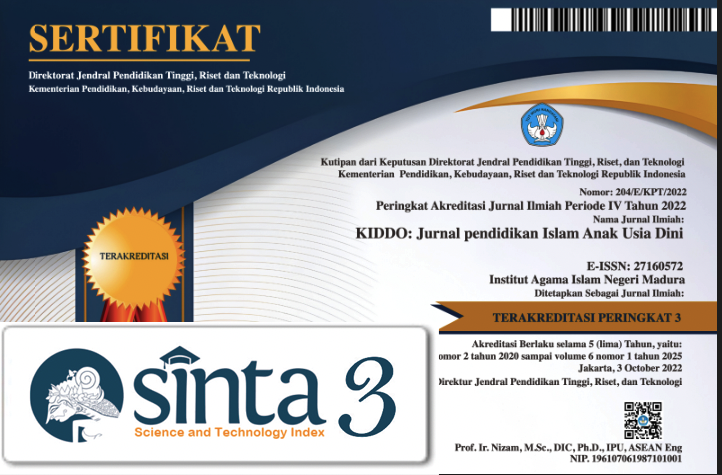Hubungan Antara Umur, Jenis Kelamin, Bentuk Tubuh, dan Kepercayaan Diri terhadap Perilaku Bullying pada Anak Usia Dini
 Abstract views: 672
,
Abstract views: 672
,
 PDF downloads: 565
PDF downloads: 565
Abstract
Bullying has occurred among children in Indonesia at various levels of education, from high school, middle school, elementary school, and even early childhood education. Bullying in Indonesia has brought a lot of psychological and physical trauma. Following these problems, this research aims to determine the bullying behavior that occurs in young children in cities and villages along with the largest percentage of the types of bullying behavior that occurs. Apart from that, this research also tested the relationship between several children's characteristics, such as age, gender, body shape, and self-confidence on bullying behavior. This research method is descriptive quantitative and correlational with a sampling technique using cluster sampling. Research data collection used a survey method by distributing questionnaires to 4 PAUD schools in Pontianak City and 4 PAUD schools in Kubu Raya Regency. From the 172 data obtained, it shows that every child, both in the city and in the village, experiences all types of bullying behavior with the largest percentage being physical bullying. This research also shows that age, gender, and self-confidence have a significant relationship to bullying behavior. Based on the research results, participation from various parties is needed to prevent and deal with bullying problems that begin in early childhood who are entering the golden age. Not only in cities, bullying in villages also needs to be given more attention, because bullying incidents in villages have a higher percentage than in cities.
Downloads
References
Bella. (2022, November 2). Miris , Seorang Siswa SDIT di Pontianak Dianiaya 4 Teman Sekelas hingga Tak Mampu Berdiri. SuaraKalbar.Id. https://kalbar.suara.com/read/2022/11/02/152935/miris-seorang-siswa-sdit-di-pontianak-dianiaya-4-teman-sekelas-hingga-tak-mampu-berdiri
Cipta, H., & Arief, T. M. V. (2022, January 7). Kasus Perundungan Bocah 7 Tahun di Pontianak Berakhir Damai , 4 Pelaku Kembali ke Orangtua. Kompas.Com, 1–2. https://regional.kompas.com/read/2022/01/07/160835678/kasus-perundungan-bocah-7-tahun-di-pontianak-berakhir-damai-4-pelaku?page=all#page2
Ernawati, R., Deliviana, E., Wigunawati, E., Hutabarat, L. E., & Intarti, E. R. (2021). Student Perceptions of Bullying. Psychology and Education Journal, 58(2), 1140–1148. https://doi.org/10.17762/pae.v58i2.2253
Ferryanto. (2023, June 17). Remaja Putri Korban Bullying di Pontianak Sempat Demam Dua Hari. TribunPontianak.Co.Id, 1–3.
Ghozali, I. (2018). Aplikasi Analisis Multivariate dengan Program IBM SPSS 25 (9th ed.). Universitas Diponegoro.
Herawati, N., & Deharnita. (2019). Gambaran Faktor-Faktor Penyebab Terjadinya Perilaku Bullying pada Anak. NERS: Jurnal Keperawatan, 15(1), 60–66.
Herman, H., Nurshal, D., & Oktarina, E. (2017). Hubungan Karakteristik Remaja dengan Perilaku Bullying pada Siswa SMP di Kota Padang. Jurnal Keperawatan Soedirman, 12(1), 1. https://doi.org/10.20884/1.jks.2017.12.1.677
Mais, T. (2022, December 5). Viral Anak TK di Sulut Jadi Korban Bully, Korban 3 Pekan Tak Mau ke Sekolah. Www.Detik.Com, 1–2. https://www.detik.com/sulsel/berita/d-6443788/viral-anak-tk-di-sulut-jadi-korban-bully-korban-3-pekan-tak-mau-ke-sekolah
Muhammadiyah, S. (2023, October 9). Sekolah Muhammadiyah Terdepan " Stop Bullying ". Suaramuhammadiyah.Id, 9–10. https://www.suaramuhammadiyah.id/read/sekolah-muhammadiyah-terdepan-stop-bullying
Olweus, D. (1994). Bullying at School: Basic Facts and Effects of a School Based Intervention Program. Journal of Child Psychology and Psychiatry, 35(7), 1171–1190. https://doi.org/10.1111/j.1469-7610.1994.tb01229.x
Paranti, S. M., & Takwin, B. (2022). Hubungan Antara School Safety dan Respons Bystander Bullying Pada Siswa SMA: Studi Perbandingan Desa-Kota. Jurnal Psikologi, 20(1), 1–10.
Peraturan Menteri Pendidikan dan Kebudayaan Nomor 146 Tahun 2014 tentang Kurikulum 2013 Pendidikan Anak Usia Dini, 65 (2014).
PeraturPeraturan Menteri Kesehatan Nomor 2 Tahun 2020 tentang Standar Antropometri Anak, 78 (2020).an Menteri Kesehatan Nomor 2 Tahun 2020 tentang Standar Antropometri Anak, 78 (2020).
Putri, H. N., Nauli, F. A., & Novayelinda, R. (2015). Faktor–Faktor yang Berhubungan dengan Perilaku Bullying pada Remaja. Jurnal Online Mahasiswa (JOM) Bidang Ilmu Keperawatan, 17(3), 56–64.
Rohman, M. Z. (2018). Hubungan antara Usia, Tingkatan Kelas, dan Jenis Kelamin dengan Kecenderungan Menjadi Korban Bullying. The 3rd Universty Research Colloquium 2016, 526–532.
Santosa, P. I. (2021). Metode Penelitian (1st ed.). Universitas Terbuka.
Solberg, M. E., & Olweus, D. (2003). Prevalence Estimation of School Bullying with the Olweus Bully/Victim Questionnaire. Aggressive Behavior, 29(3), 239–268. https://doi.org/10.1002/ab.10047
Sukmawati, R. (2023, November 3). Viral Video Dugaan Bullying Siswa SMA di Pontianak, Korban Ramai-ramai Dipukul Sambil Disoraki. TribunJabar.Id.
Sulis, H. (2016, January 24). Kasus Bullying di Lampung, Anak TK Rebut Bekal Temannya lalu Diinjak-injak. TribunLampung.Co.Id, 1. https://lampung.tribunnews.com/2016/01/24/kasus-bullying-di-lampung-anak-tk-rebut-bekal-temannya-lalu-diinjak-injak
Unicef. (2020). Cara Membicarakan Bullying dengan Anak Anda Tips untuk orang tua. Unicef Indonesia. https://www.unicef.org/indonesia/id/cara-membicarakan-bullying-dengan-anak-anda
Copyright (c) 2024 Dewi Anggraeni, Diana, Yuniarti

This work is licensed under a Creative Commons Attribution 4.0 International License.
-
The journal operates an Open Access policy under a Creative Commons 4.0 International license. The terms of the license are:
Share— copy and redistribute the material in any medium or format
Adapt— remix, transform, and build upon the material for any purpose, even commercially.
1. Authors retain copyright and grant the journal right of first publication with the work simultaneously licensed under a Creative Commons License.that allows others to share the work with an acknowledgement of the work’s authorship and initial publication in this journal
2. Authors are permitted and encouraged to post their work online (e.g., in institutional repositories or on their website) prior to and during the submission process, as it can lead to productive exchanges, as well as earlier and greater citation of published work (See The Effect of Open Access).
Jurnal Kiddo is licensed under a Creative Commons
n Access).














